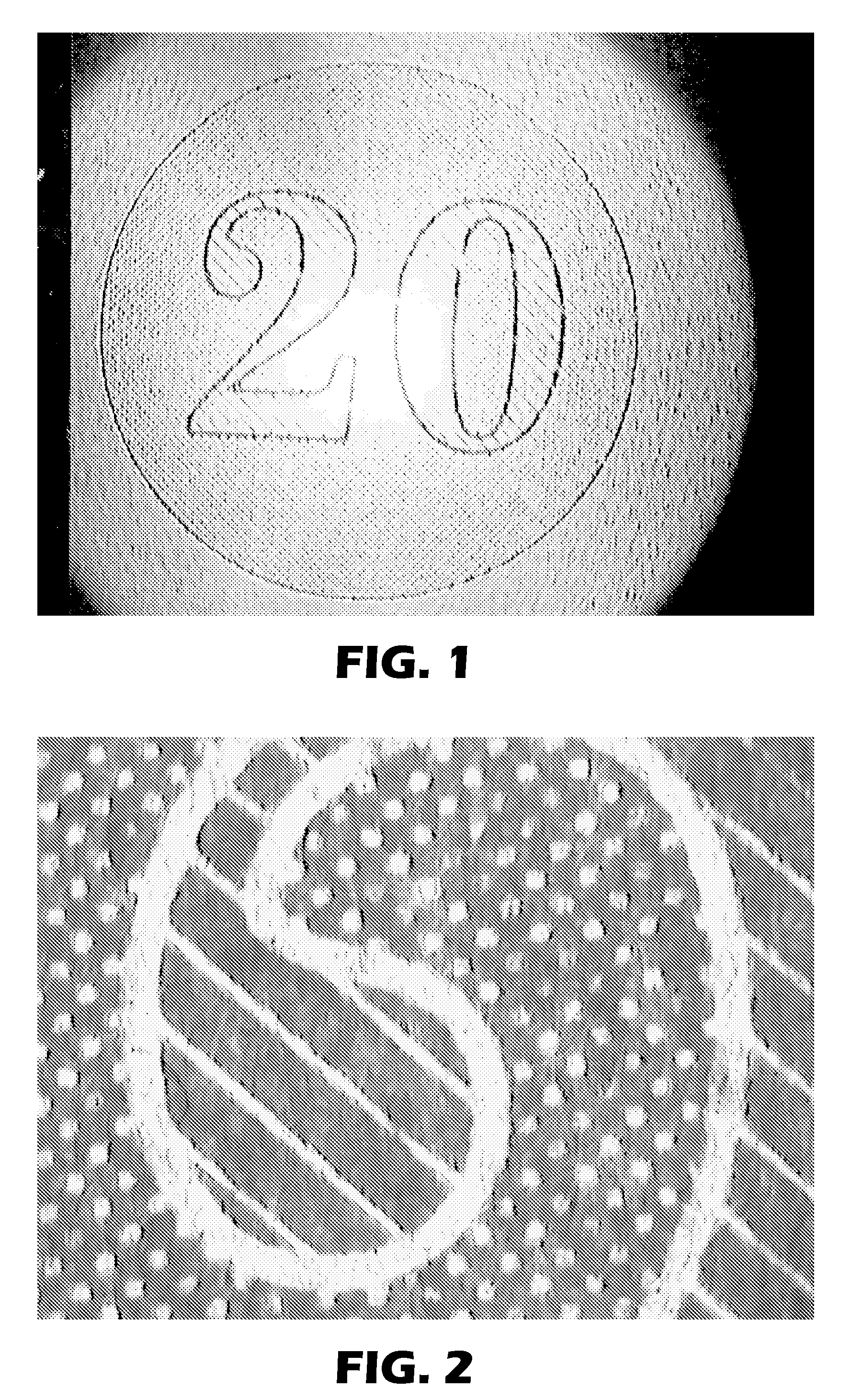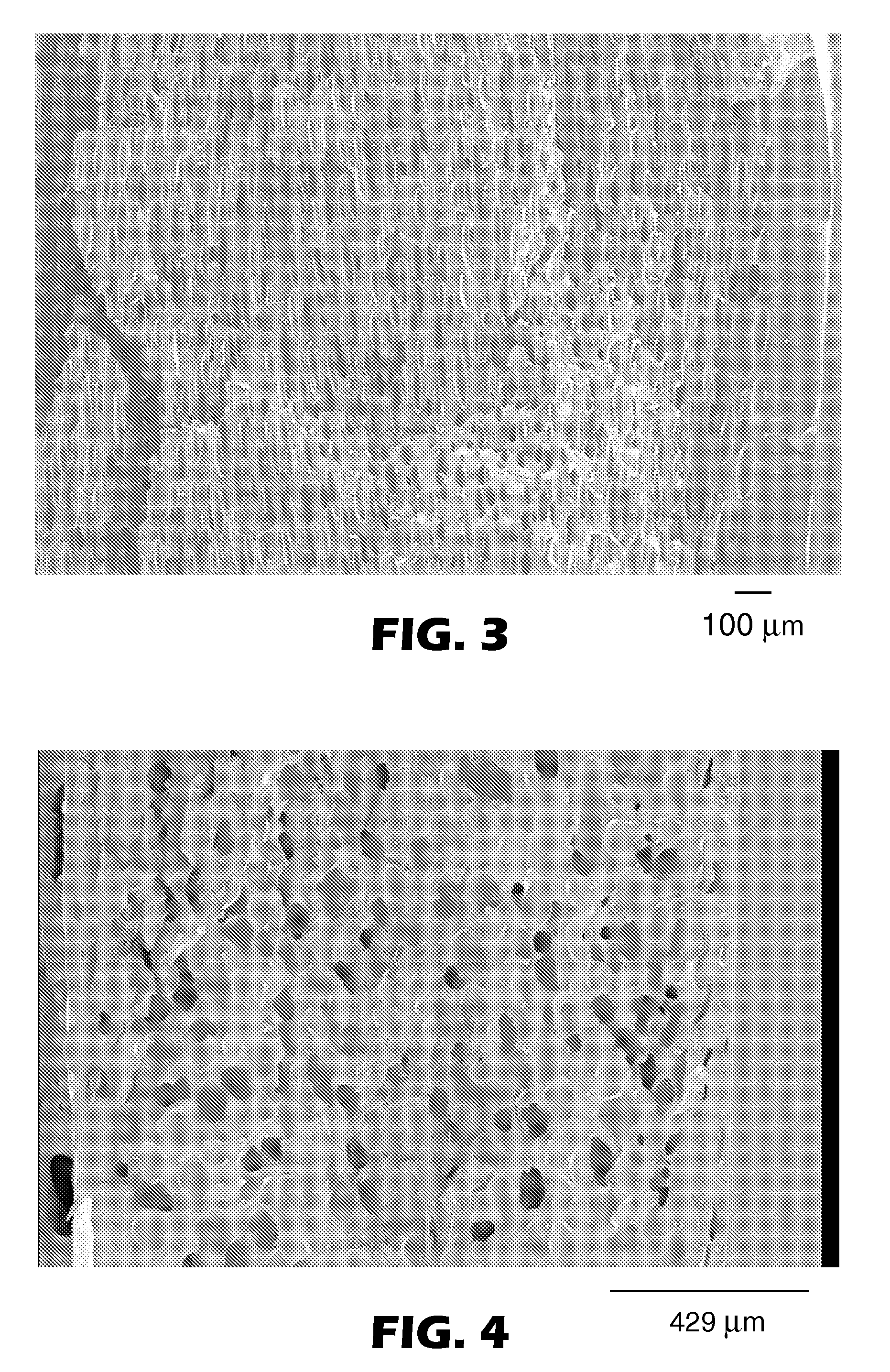Ink-receptive foam article
a foam article and foam technology, applied in the field of oriented foam articles, can solve the problems of inability to absorb ink, lack of inherent capacity of film materials, and inability to meet the needs of image-forming ink on polymeric substrates, and achieve the effect of increasing the crystallinity
- Summary
- Abstract
- Description
- Claims
- Application Information
AI Technical Summary
Benefits of technology
Problems solved by technology
Method used
Image
Examples
example 1
[0153] A melt mixture of 67% high melt strength polypropylene (Profax PF814™, Montell North America, Inc., Wilmington, Del.), 28% elastomeric copolyethylene, Affinity 8200 (Dow Chemical, Midland, Mich.), and 5% by weight of FM1307H™ chemical blowing agent (50% azodicarbonamide loaded in polyethylene) (Ampacet Co., Cincinnati, Ohio) was prepared in a 5.1 cm single screw extruder (SSE) (Davis-Standard Corp., Cedar Grove, N.J.) equipped with a Saxton single stage screw at 60 rpm and a temperature profile from 135 to 221 to 141° C. The exit melt temperature was 141° C., creating an exit pressure of 11 MPa. The melt mixture was extruded into the core of a 203 mm single layer die at 160° C. with no skins. The resulting foam sheet was cooled on a chrome cast roll at 67° C., then collected at a draw rate of 2.5 m / min. The foam had a density of 0.5 g / cc at a thickness of 1.65 mm. A single layer foam was created with cell sizes slightly elongated in the machine direction (MD), the cells measu...
example 2
[0157] A melt mixture of 98.0% Profax PF814 and 2.0% FM1307H™ was prepared in a 60 mm twin screw extruder (Berstorff, Florence, Ky.) at 84 rpm and a temperature profile from 180 to 230 to 150° C. The exit melt temperature was 167° C., creating an exit pressure of 82.2 bar. The melt mixture was extruded into the core of an 457 mm 5-layer vane die at 175° C. A 64 mm Davis Standard SSE at 41 rpm and a 51 mm Davis Standard SSE at 75 rpm were used to feed into the die two skin layers, which consisted of isotactic polypropylene, PP 3571™ (Fina Inc., Dallas, Tex.). The resulting foam sheet was cooled on a partially water-immersed chrome cast roll at 20° C. at 3.1 m / min. A three-layer foam was created with foam cell sizes noticeably elongated in the machine direction, the cells measuring 20×80 micrometers. The skin / core / skin thickness ratio was approximately 12:76:12.
[0158] This foam was biaxially oriented in simultaneous fashion using a Bruckner LISIM line (Bruckner Inc.) at a draw ratio ...
example 3
[0162] A melt mixture of 34.2% high melt strength polypropylene, Profax PF814™, 34.2% conventional polypropylene, PP 3376™ (Fina Inc., Dallas, Tex.), 29.2% elastomeric Affinity 8200™, and 2.4% by weight of FM1307H™ was prepared in a 6.3 cm single screw extruder (SSE, Davis-Standard) equipped with a Saxton single stage screw at 44.4 rpm and a temperature profile from 146 to 233 to 149° C. The exit melt temperature was 133° C., creating an exit pressure of 16.6 MPa. The melt mixture was extruded into the core of a 25.4 cm 3-layer vane die at 182° C. where it met the 50 / 50 PP 3571 / PP 3376™ (Fina) skins. The skins were extruded from a 38.1 mm Davis Standard SSE running at 218° C., 100 rpm. The resulting foam sheet was cooled on a chrome cast roll at 17° C., then collected at a draw rate of 5.2 m / min. The foam had a density of 0.56 g / cc at a thickness of 1.3 mm.
[0163] This foam was oriented in the MD using an LO and in the CD using a tenter at a draw ratio of 2.5 (MD)×5.2 (CD). The temp...
PUM
| Property | Measurement | Unit |
|---|---|---|
| melt strength | aaaaa | aaaaa |
| melt strength | aaaaa | aaaaa |
| melt temperature | aaaaa | aaaaa |
Abstract
Description
Claims
Application Information
 Login to View More
Login to View More - R&D
- Intellectual Property
- Life Sciences
- Materials
- Tech Scout
- Unparalleled Data Quality
- Higher Quality Content
- 60% Fewer Hallucinations
Browse by: Latest US Patents, China's latest patents, Technical Efficacy Thesaurus, Application Domain, Technology Topic, Popular Technical Reports.
© 2025 PatSnap. All rights reserved.Legal|Privacy policy|Modern Slavery Act Transparency Statement|Sitemap|About US| Contact US: help@patsnap.com



